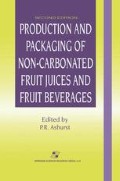Abstract
Water is colourless, odourless, tasteless and is essential for the continued existence of the human race. The water that is available in the world is continually recycled by means of the hydrological cycle. During this process water from the sea, rivers and lakes is evaporated by the sun and forms clouds in the atmosphere. The changing atmospheric conditions then cause the water to descend to the earth in the form of rain, sleet, hail or snow. Initially, the water released from the clouds is very pure, but as it falls it picks up impurities such as carbon dioxide, dust, smoke, nitrogen, oxygen and other atmospheric gases. When it reaches the earth, the water collects small amounts of soil particles, inorganic and organic matter, bacteria, algae and other foreign materials, dependent on the environment in which it falls. Ordinary water, therefore, contains various impurities in variable amounts. These impurities will, to a greater or lesser degree, adversely affect the flavour of the water.
Access this chapter
Tax calculation will be finalised at checkout
Purchases are for personal use only
Preview
Unable to display preview. Download preview PDF.
References
Barnes, O., Forster, C. P. and Hruday, S. E. (eds.) (1984) Surveys in Industrial Wastewater Treatment, Food and Allied Industries,Pitman.
Dean Adams, V. (ed.) (1990) Water and Wastewater Examination Manual,Lewis.
Endress and Hauser (eds.) (1992) Wastewater Measurement and Automation,ISBN 3–9520220–1–2.
Horan, N. (ed.) (1990) Biological Wastewater Treatment Systems, Theory and Operation, Wiley. Jenkins and Richard (1993) Manual on the Causes and Control of Activated Sludge Bulking and Foaming, 2nd edn., Daigger, Lewis.
Metcalfe and Eddy (eds.) (1991) Wastewater Engineering, Treatment, Disposal and Reuse,3rd edn., McGraw-Hill.
Rotheryl, B. (1993) BS 7750, Implementing the Environment Management Standard and the EC Eco Management Scheme, Gower.
Tebbutt, T. H. Y. (ed.) (1992) Principles of Water Quality Control,4th edn., Pergamon.
Editor information
Editors and Affiliations
Rights and permissions
Copyright information
© 1999 Springer Science+Business Media New York
About this chapter
Cite this chapter
Paterson, I., Cooke, P.J. (1999). Water and effluent treatment in juice processing. In: Ashurst, P.R. (eds) Production and Packaging of Non-Carbonated Fruit Juices and Fruit Beverages. Springer, Boston, MA. https://doi.org/10.1007/978-1-4757-6296-9_15
Download citation
DOI: https://doi.org/10.1007/978-1-4757-6296-9_15
Publisher Name: Springer, Boston, MA
Print ISBN: 978-1-4419-5191-5
Online ISBN: 978-1-4757-6296-9
eBook Packages: Springer Book Archive

